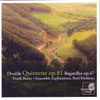Dvorák Bagatelles; Piano Quintet Op 81
Sparkling playing distinguishes this new version of a masterly quintet
View record and artist detailsRecord and Artist Details
Composer or Director: Antonín Dvořák
Genre:
Chamber
Label: Harmonia Mundi
Magazine Review Date: 8/2007
Media Format: CD or Download
Media Runtime: 54
Mastering:
Stereo
DDD
Catalogue Number: HMC901880

Tracks:
| Composition | Artist Credit |
|---|---|
| Quintet for Piano and Strings |
Antonín Dvořák, Composer
Antonín Dvořák, Composer Ensemble Explorations Frank Braley, Piano |
| Bagatelles |
Antonín Dvořák, Composer
Antonín Dvořák, Composer Ensemble Explorations Frank Braley, Harmonium |
Author: Edward Greenfield
Recorded in warm, full sound, pianist Frank Braley leads an often fiery and impulsive account of Dvorák’s masterly Piano Quintet (1887), using a vintage Steinway of 1874. The clarity of his articulation adds sparkle to his freely romantic reading, matched by the players of Ensemble Explorations. Richter with the Borodin Quartet, recorded live in 1982, leads a smoother reading, sweetly expressive, while Curzon in his vintage Viennese version allows less extreme contrasts of speed between the sharply defined sections. Though the recording is by far the oldest (1962), it remains impressive, being made in the Sofiensaal in Vienna with John Culshaw relishing his favourite recording venue.
In the slow movement, marked Dumka, Braley leads a reading poised in the slower sections, making an effective contrast with the faster sections, which are not as sharply different as in most dumka movements. The contrasts of tone and dynamic are most persuasive. Curzon by contrast leads a performance so slow that it is in danger of stagnating, beautiful as the playing is, and Richter’s reading is also slow but well sustained. In the third-movement Furiant, all three readings are fast and light, while the finale inspires Braley and his partners to spring the rhythms infectiously, with thrust and swagger.
The coupling on the new version brings a welcome rarity, written in 1878, the year of the first set of Slavonic Dances, for two violins, cello and harmonium, an instrument popular at the time, particularly in America. The sequence is delightful in its exploiting of fresh ideas, and Braley readily adapts to the demands of the harmonium. It is not a generous coupling but a very attractive one, completing a first-rate disc, well recorded.
In the slow movement, marked Dumka, Braley leads a reading poised in the slower sections, making an effective contrast with the faster sections, which are not as sharply different as in most dumka movements. The contrasts of tone and dynamic are most persuasive. Curzon by contrast leads a performance so slow that it is in danger of stagnating, beautiful as the playing is, and Richter’s reading is also slow but well sustained. In the third-movement Furiant, all three readings are fast and light, while the finale inspires Braley and his partners to spring the rhythms infectiously, with thrust and swagger.
The coupling on the new version brings a welcome rarity, written in 1878, the year of the first set of Slavonic Dances, for two violins, cello and harmonium, an instrument popular at the time, particularly in America. The sequence is delightful in its exploiting of fresh ideas, and Braley readily adapts to the demands of the harmonium. It is not a generous coupling but a very attractive one, completing a first-rate disc, well recorded.
Discover the world's largest classical music catalogue with Presto Music.

Gramophone Digital Club
- Digital Edition
- Digital Archive
- Reviews Database
- Full website access
From £8.75 / month
Subscribe
Gramophone Full Club
- Print Edition
- Digital Edition
- Digital Archive
- Reviews Database
- Full website access
From £11.00 / month
Subscribe
If you are a library, university or other organisation that would be interested in an institutional subscription to Gramophone please click here for further information.




